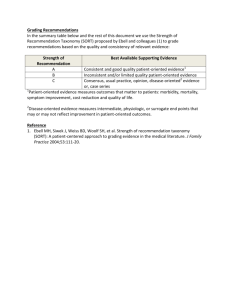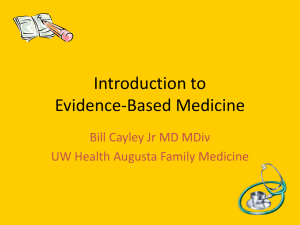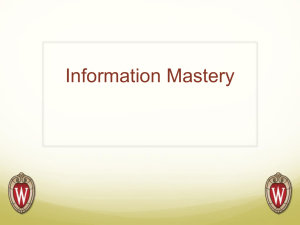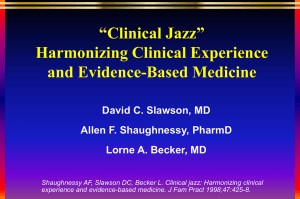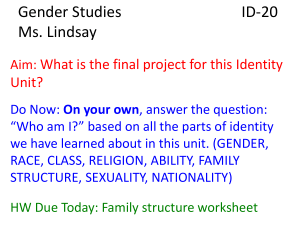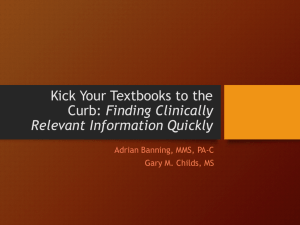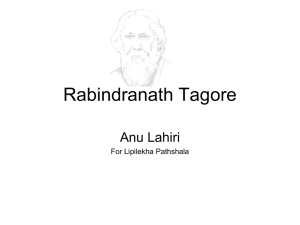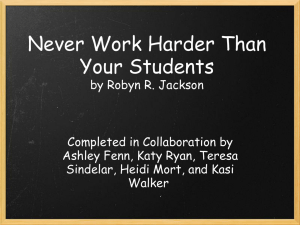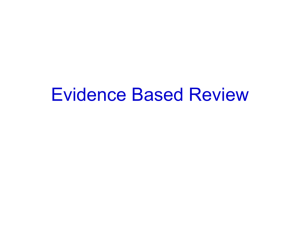Comprehensive version - Tufts University School of Medicine
advertisement
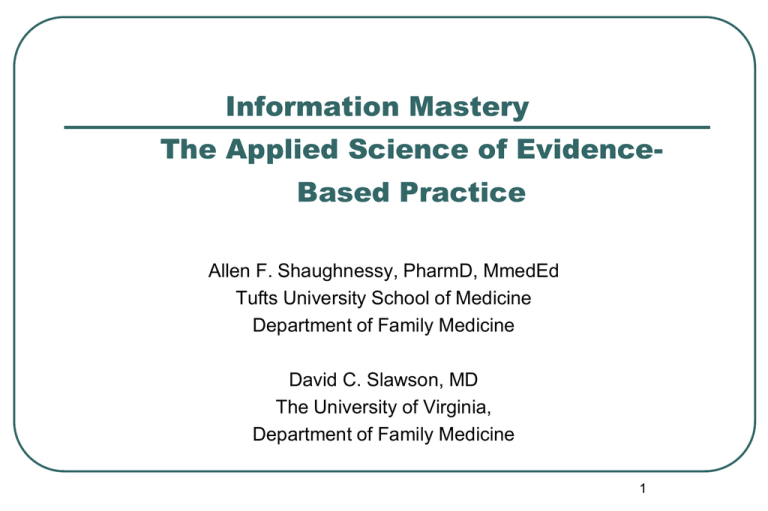
Information Mastery The Applied Science of EvidenceBased Practice Allen F. Shaughnessy, PharmD, MmedEd Tufts University School of Medicine Department of Family Medicine David C. Slawson, MD The University of Virginia, Department of Family Medicine 1 According to the Bible, how many antelopes did Noah take into the Ark? Of every clean beast thou shalt take to sevens thee by , the male and his female: and of beasts that are not clean by two, the male and his female. Of fowls also of the air by sevens, the male and the female; to keep seed alive upon the face of all the earth. Genesis. Ch 7; v2 2 How we acquire and use information Where did you get the information from to make that snap decision? If you had had time (and interest), what would you have done to make sure you had the right answer? 3 Evidence and Decision-Making Most decisions are based on what we think is the evidence, not what we know is the evidence We use brief reading and talking to other people as our information sources No one has time to appraise all of the evidence 4 This workshop has been presented in: Most of the US Canada Israel Saudi Arabia England Wales Hong Kong Taiwan Denmark 5 Where are we going? EBM/EBP applied to everyday practice Main message of conference: Not all evidence is ready for clinical application • • How to distinguish must-know from nice-to-know information How to identify information that may not be valid Sources of information vary in their usefulness Evidence at the point of care requires the use of appropriate information tools The future of healthcare relies on the appropriate use of resources • Avoiding underuse, overuse, misuse 6 How we will get there? Concepts, practice, modeling Introduction of the ideas behind EBM/EBP and information mastery Practice applying the ideas Modeling different ways of teaching the material • • • Modified problem-based learning Lecture presentations Hands-on practice • Evaluating information • Using evidence tools You are all teachers and leaders of the “revolution/solution”!!!! 7 8 Lee RV, Eimerl S. The Physician. New York, NY: Time Inc; 1967:154. 10 Focusing on outcomes that matter POE: Patient-oriented evidence • mortality, morbidity, quality of life • Live longer and/or better DOE: Disease-oriented evidence • pathophysiology, pharmacology, etiology Shaughnessy AF, Slawson DC, Bennett JH. Becoming an Information Master: A Guidebook to the Medical Information Jungle. The Journal of Family Practice 1994;39(5):489-99. 11 Patient-oriented evidence contradicts diseaseoriented evidence Disease-Oriented Outcome Patient-Oriented Outcome Intensive glucose lowering can decrease A1c Intensive glucose lowering does not decrease mortality Beta-carotene, Vit E are good antioxidants Neither prevents cancer or CV disease Erythropoeitin in patients with chronic renal failure increases Hemoglobin Erythropoietin increases mortality in patients with chronic renal failure Telmisartan (Benicar) lowers blood pressure Telmisartan increases the risk of adverse cardiovascular events 12 Determining whether information is relevant and does it matter? Does it address an outcome people care about (Patient-oriented evidence)? Is the intervention feasible? If it is true, will it require you to change your practice? Yes to all three – Patient-Oriented Evidence that Matters 13 The new paradigm: probabilistic thinking Current paradigm: the biomedical model • The body can be approached as an engineering problem • External fetal monitoring Nelson KB, Dambrosia JM, Ting TY, Grether JK. Uncertain value of electronic fetal monitoring in predicting cerebral palsy. N Engl J Med 1996;334:613-8. • Right heart catheterization Shah MR, et al. Impact of the pulmonary artery catheter in critically ill patients: meta-analysis of randomized clinical trials. JAMA. 2005 Oct 5;294(13):1693-4. The new paradigm: Probabilities • What can we do for people that, on average, will help most of them most of the time? 14 What is Evidence-Based Medicine? “The judicious use of the best current evidence in making decisions about the care of the individual patient.” --EBM working group “An acknowledgment that there is a hierarchy of evidence and that conclusions related to evidence from controlled experiments are accorded greater credibility than conclusion grounded in other sorts of evidence.” -- Brian Hurwitz. BMJ 2004;329:1024-8. 15 The Hierarchy of Evidence Credibility Results from controlled trials Results from case-control studies Results from case series Expert consensus or opinion Pathophysiologic reasoning 16 The Place of EBM in Medicine Goals of medicine: Relieve/prevent suffering; maintain/provide hope; prevent, treat, or cure disease The science of medicine: knowing the best way to prevent, treat, or cure disease (EBM can address this aspect) The art of medicine: Determining, using intuition, experience, and judgment, what patients need the most Combining the art and science Clinical Jazz 17 Feeling Good About Not Knowing Everything: Information Mastery Prioritize efforts to identify, validate, and apply common POEMs Responsibility: less to read, but more important to find and evaluate The Information Mastery Traffic Light Red: Don’t for most people most of the time Yellow: Benefit/harm uncertain Green: Most of the time for most people The Information Mastery Traffic Light But the lights may change . . . • • Red to Green: B-blockers for CHF Green to Red: HRT for postmenopausal women Why? Practice before valid POEMs were known Yellow: Keep an open mind — be ready to update DOEs and ? valid POEMs (low LOE) If it’s not a valid POEM, it’s not necessarily so Keeping Up in the Real World Read few original articles, only if forced Get rid of the bedside stack Use Foraging Tools • Sources of valid information filtered for relevance to practice • Foraging session Goal: “Confidence through Information” Relevance Frequency of Problem Common Patient-Oriented Evidence Best Type of Evidence Disease-Oriented Evidence Caution Rare Only if Time Worst POEMs Finding Answers in the Real World: Hunting Tools Use summary sources that filter for relevance & validity: • • • • Dynamed Clinical Evidence The Cochrane Library Essential Evidence Plus The Clinician of the Future (NOW!) “I know a lot, therefore I am” • Replaceable by a computer “I think, therefore I am” • • Never replaceable by computer Travel agent – should they memorize schedules? • Would you trust them? • “How do you know?” Bedside computer = “stethoscope of the present” Take-Home Points Confidence through information Hunting & foraging tools providing relevant and valid information when needed • Focus on valid POEMs – Patient-Oriented Evidence that Matters Take-Home Points Clinicians will be/are valued by how they think and not by what they know The information age is about information management, not information acquisition Thinking in probabilities, not mechanics
